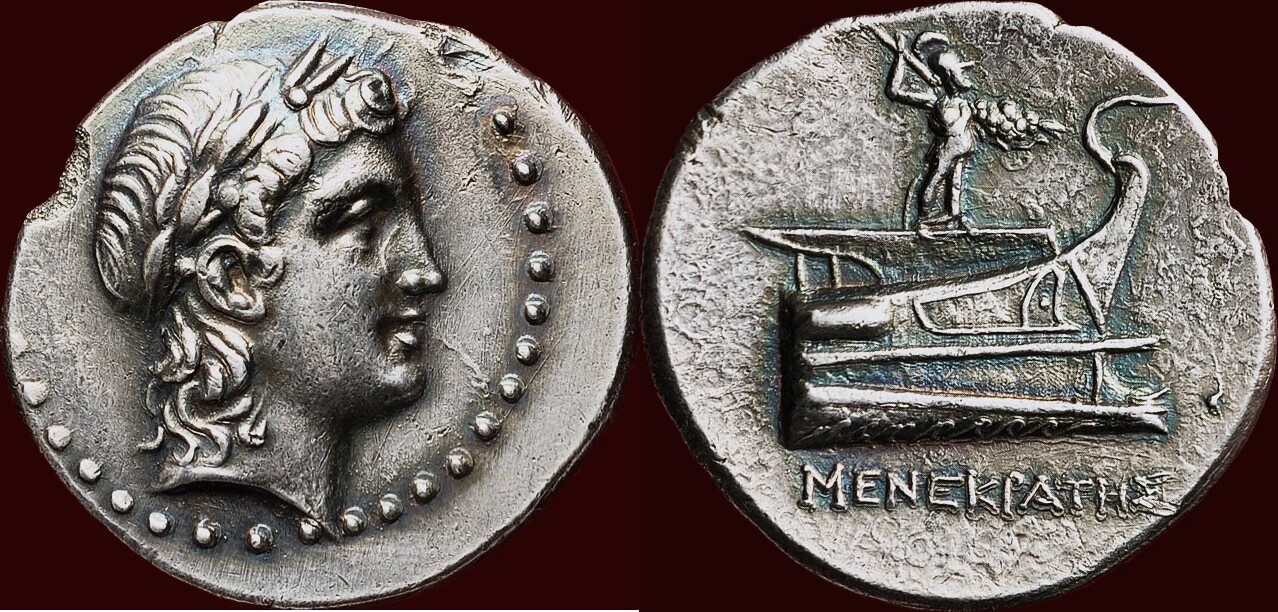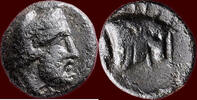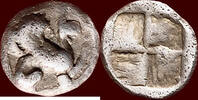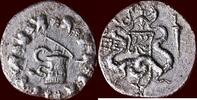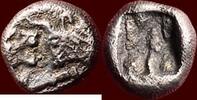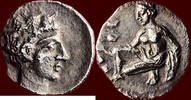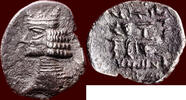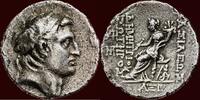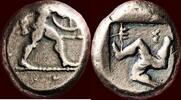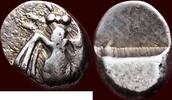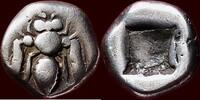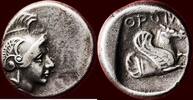MA-ID: 7683202010
Customer feedback Henzen
Schnelle Lieferung. Super Ware. Vielen Dank!
O.K.
perfekt !!!
Great coin, quick delivery, thanks!
AR Stater 167-130 BC v. Chr. LYCIA, PHASELIS - MENEKRATES, magistrate - circa 167-130 BC xf-/xf
Munthandel G.Henzen 

10
On MA-Shops since 10 years
7244 ratings,
100 % Positive (last 24 months)
Worldwide shipping
4,768.23 £5500,00 EUR
Import tax may be added
+ 24.27 £ shipping ( to United Kingdom )
Delivery time: 5 - 8 days
+ 24.27 £ shipping ( to United Kingdom )
| Customer Support +49 (0)2871 2180 383 |
| Payment methods |
| Wire Transfer |
weight 11,16gr. | silver Ø 27mm.
obv. Laureate head of Apollo right within border of dots
rev. Prow of galley right, surmounted by Athena standing right, brandishing thunderbolt
and holding aegis, beneath prow MENEKPATHΣ
Settlers from nearby Rhodes established a colony in 690 BC, which would become the city of Phaselis.In fact is was the only purely Greek city within Lycia. With three separate natural harbors the city soon became a major trading center. Phaselis was incorporated into the Persian Empire in 546 BC and then conquered by the Athenians under Kimon in 469 BC. In the 4th century BC Persian rule was re-established and Phaselis was allied with the satrap Mausollos from Halicarnassos. In 333-334 BC, during his campaign against the Persians, Alexander the Great and his naval fleet led by his admiral Nearchos was welcomed at Phaselis where he remained for the winter. After the death of Alexander, Phaselis was ruled in turn from Ptolemaic Egypt, Seleucid Syria and Rhodes, until 160 BC when it was absorbed into the Lycian confederacy under Roman domination.
The people from Phaselis sailed far afield from an early date, for they played a part in the trading station at Naucratis in Egypt from early in the sixth century BC or before. Their coinage was certainly one of the earliest in the area, and from the start its type bears witness to the maritime interests of Phaselis. It is the prow of a warship, which is constructed to resemble the forepart of a boar. The Phaselis tradesmen were well-known in ancient times in famous cities from Athens to Rome and Alexandria to Rhodes. But actually they didn′t have a really good reputation. A comment of the famous Greek orator Demosthenos reflects this he characterizes the people of Phaselis as treacherous and inhumane. The famous harpist Stratonikos replied to the question of ″which people are most unreliable″, he answered ″in Pamphylia the people of Phaselis, across the world the people of Side″ . This also illustrates the rivalry between the cities of Side, in Pamphylia, and Phaselis. Pirates under the command of Zenecites overran Phaselis and nearby Olympos in the 1st century BC until Rome re-established control in 78 BC. During the Roman civil wars, Brutus bullied Phaselis into contributing funds. When emperor Hadrian visited the city in 131, Phaselis was adorned with new statues, monuments and buildings in his honor.
The foundation of the city by a certain Lakios from Rhodian Lindos is historically verifiable. The harbor towns on the island of Rhodes needed Lycian timber for shipbuilding and therefore founded several colonies around the south-eastern tip of Lycia. The staters of Phaselis, which were minted between 167 and 130 BC, depict a laurel-wreathed head of Apollo on the obverse and a lightning-throwing Athena standing on the bow of a ship on the reverse. Athena was the main goddess of the mother city of Lindos. Menekrates is a quite common Greek name. The first element of this name is derived from Greek μενω (meno) meaning "to stay, to remain" as well as "to last, to withstand". The second element is derived from Greek κρατος (kratos) meaning "power". Only a few specimens are known from this magistrate. Extremely rare. BMC- | SNG.Copenhagen- | SNG.von Aulock- |
McClean- | Müseler- | Heipp-Tamer 338 RRR
Small edgechip, otherwise very rare and attractive coin of good style.
xf-/xf
obv. Laureate head of Apollo right within border of dots
rev. Prow of galley right, surmounted by Athena standing right, brandishing thunderbolt
and holding aegis, beneath prow MENEKPATHΣ
Settlers from nearby Rhodes established a colony in 690 BC, which would become the city of Phaselis.In fact is was the only purely Greek city within Lycia. With three separate natural harbors the city soon became a major trading center. Phaselis was incorporated into the Persian Empire in 546 BC and then conquered by the Athenians under Kimon in 469 BC. In the 4th century BC Persian rule was re-established and Phaselis was allied with the satrap Mausollos from Halicarnassos. In 333-334 BC, during his campaign against the Persians, Alexander the Great and his naval fleet led by his admiral Nearchos was welcomed at Phaselis where he remained for the winter. After the death of Alexander, Phaselis was ruled in turn from Ptolemaic Egypt, Seleucid Syria and Rhodes, until 160 BC when it was absorbed into the Lycian confederacy under Roman domination.
The people from Phaselis sailed far afield from an early date, for they played a part in the trading station at Naucratis in Egypt from early in the sixth century BC or before. Their coinage was certainly one of the earliest in the area, and from the start its type bears witness to the maritime interests of Phaselis. It is the prow of a warship, which is constructed to resemble the forepart of a boar. The Phaselis tradesmen were well-known in ancient times in famous cities from Athens to Rome and Alexandria to Rhodes. But actually they didn′t have a really good reputation. A comment of the famous Greek orator Demosthenos reflects this he characterizes the people of Phaselis as treacherous and inhumane. The famous harpist Stratonikos replied to the question of ″which people are most unreliable″, he answered ″in Pamphylia the people of Phaselis, across the world the people of Side″ . This also illustrates the rivalry between the cities of Side, in Pamphylia, and Phaselis. Pirates under the command of Zenecites overran Phaselis and nearby Olympos in the 1st century BC until Rome re-established control in 78 BC. During the Roman civil wars, Brutus bullied Phaselis into contributing funds. When emperor Hadrian visited the city in 131, Phaselis was adorned with new statues, monuments and buildings in his honor.
The foundation of the city by a certain Lakios from Rhodian Lindos is historically verifiable. The harbor towns on the island of Rhodes needed Lycian timber for shipbuilding and therefore founded several colonies around the south-eastern tip of Lycia. The staters of Phaselis, which were minted between 167 and 130 BC, depict a laurel-wreathed head of Apollo on the obverse and a lightning-throwing Athena standing on the bow of a ship on the reverse. Athena was the main goddess of the mother city of Lindos. Menekrates is a quite common Greek name. The first element of this name is derived from Greek μενω (meno) meaning "to stay, to remain" as well as "to last, to withstand". The second element is derived from Greek κρατος (kratos) meaning "power". Only a few specimens are known from this magistrate. Extremely rare. BMC- | SNG.Copenhagen- | SNG.von Aulock- |
McClean- | Müseler- | Heipp-Tamer 338 RRR
Small edgechip, otherwise very rare and attractive coin of good style.
xf-/xf
Please respect our order minimum of 20 Euros. For EU only IBAN payment please. Shippings to China are on risk of the buyer and only payment by bankwire or WISE. Shipping will take place within 5 days after receipt of payment. Sendings to Russia,Ukraine and Israel are not possible. Additional administration- and risk costs for PayPal & creditcard payments. No PayPal or creditcardpayments possible for orders over 10.000 euro.
| Shipping fees | ||||
|---|---|---|---|---|
| up to 86.70 £ | 86.70 £ to 433.48 £ | 433.48 £ to 866.95 £ | over 866.95 £ | |
| Argentina | 27.74 £ | 27.74 £ | 34.68 £ | 34.68 £ |
| Australia | 30.34 £ | 30.34 £ | 34.68 £ | 34.68 £ |
| Belgium | 8.24 £ | 9.54 £ | 11.27 £ | 15.61 £ |
| Brazil | 47.68 £ | 47.68 £ | 47.68 £ | 47.68 £ |
| Bulgaria | 12.14 £ | 13.87 £ | 30.34 £ | 39.01 £ |
| Chile | 43.35 £ | 43.35 £ | 43.35 £ | 43.35 £ |
| China | 34.68 £ | 34.68 £ | 43.35 £ | 43.35 £ |
| Denmark | 9.97 £ | 11.27 £ | 13.87 £ | 17.34 £ |
| Germany | 8.24 £ | 9.54 £ | 11.27 £ | 15.61 £ |
| Estonia | 11.27 £ | 12.14 £ | 13.00 £ | 21.67 £ |
| France | 8.24 £ | 9.54 £ | 13.87 £ | 21.67 £ |
| Greece | 13.00 £ | 21.67 £ | 26.01 £ | 30.34 £ |
| United Kingdom | 21.67 £ | 21.67 £ | 22.54 £ | 24.27 £ |
| Hong Kong | 34.68 £ | 34.68 £ | 43.35 £ | 43.35 £ |
| India | 30.34 £ | 30.34 £ | 34.68 £ | 43.35 £ |
| Indonesia | 30.34 £ | 30.34 £ | 34.68 £ | 34.68 £ |
| Israel | 173.39 £ | 173.39 £ | 173.39 £ | 173.39 £ |
| Japan | 34.68 £ | 34.68 £ | 34.68 £ | 34.68 £ |
| Cambodia | 56.35 £ | 56.35 £ | 56.35 £ | 56.35 £ |
| Canada | 26.01 £ | 26.01 £ | 30.34 £ | 30.34 £ |
| Liechtenstein | 17.34 £ | 17.34 £ | 21.67 £ | 21.67 £ |
| Luxembourg | 9.54 £ | 11.27 £ | 13.87 £ | 21.67 £ |
| Malaysia | 30.34 £ | 30.34 £ | 34.68 £ | 39.01 £ |
| Netherlands | 7.37 £ | 7.37 £ | 9.54 £ | 12.14 £ |
| Norway | 21.67 £ | 21.67 £ | 26.01 £ | 30.34 £ |
| Austria | 9.97 £ | 10.84 £ | 13.00 £ | 21.67 £ |
| Poland | 11.27 £ | 12.14 £ | 14.30 £ | 21.67 £ |
| Portugal | 11.27 £ | 12.14 £ | 15.61 £ | 21.67 £ |
| Romania | 13.87 £ | 15.61 £ | 21.67 £ | 30.34 £ |
| Russian Federation | 173.39 £ | 173.39 £ | 173.39 £ | 173.39 £ |
| Switzerland | 26.01 £ | 26.01 £ | 34.68 £ | 34.68 £ |
| Serbia | 21.67 £ | 21.67 £ | 26.01 £ | 30.34 £ |
| Singapore | 30.34 £ | 30.34 £ | 30.34 £ | 34.68 £ |
| Slovakia | 11.27 £ | 13.00 £ | 17.34 £ | 21.67 £ |
| Spain | 9.97 £ | 11.70 £ | 14.30 £ | 21.67 £ |
| Sri Lanka | 30.34 £ | 30.34 £ | 34.68 £ | 39.01 £ |
| Czech Republic | 10.40 £ | 12.14 £ | 15.61 £ | 21.67 £ |
| Ukraine | 173.39 £ | 173.39 £ | 173.39 £ | 173.39 £ |
| Hungary | 12.14 £ | 13.87 £ | 21.67 £ | 26.01 £ |
| United States | 27.74 £ | 27.74 £ | 30.34 £ | 34.68 £ |
| European Union | 13.00 £ | 14.74 £ | 21.67 £ | 26.01 £ |
| World | 34.68 £ | 34.68 £ | 43.35 £ | 43.35 £ |
Information
Online orders are welcome as always and will be shipped directly.
|
Seller Home | 0Shopping cart | Terms of sale | Contact | MA Terms of sale | Privacy policy | Warranty | MA-Shops New Items Copyright ® 2001-2025, MA-SHOPS Coins All Rights Reserved. Designated trademarks and brands are the property of their respective owners. |
 Buy coins with warranty
Buy coins with warranty



